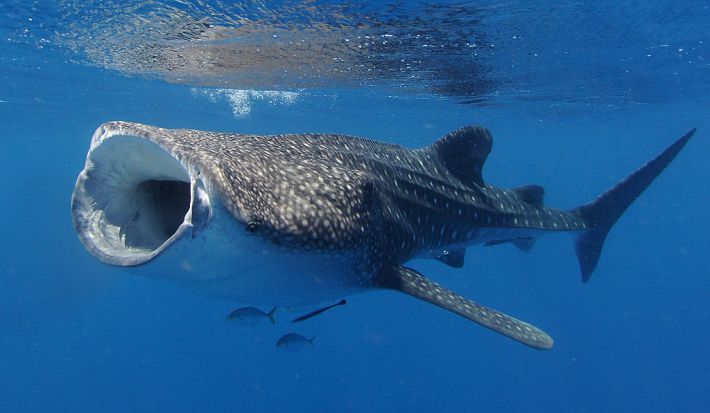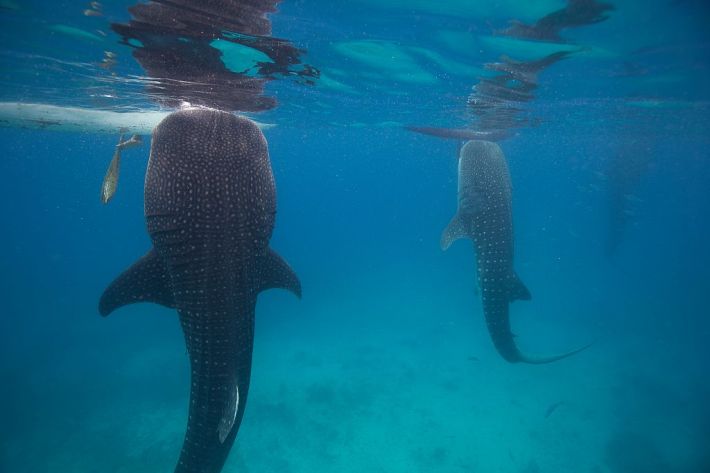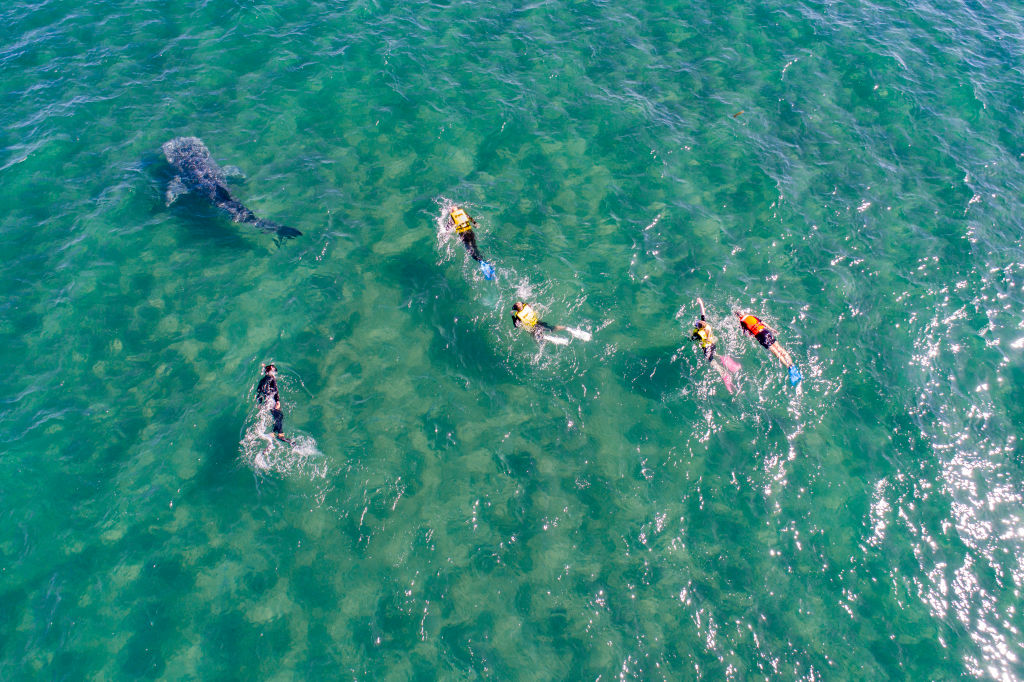Ever since Jaws came out in 1975, sharks have been in desperate need of good PR. The film struck fear in the hearts of swimmers and launched a frenzy of shark trophy hunting. This bad reputation only became more confusing as Shark Week pivoted to sensationalism with threateningly named shows like Great White Kill Zone: Guadalupe or scripted dramas reinterpreting actual shark-related disasters, hammering home the message that the last thing you want to do with sharks is swim with them. So it's unsurprising that the shark that has come to rescue its toothier brethren from their maligned image is the whale shark—an enormous and enchanting fish whose thousands of teeth are so tiny as to be functionally useless. Whale sharks have become the shark people actively dream of swimming alongside. And this dream is achievable, which is to say, it can be bought.
Whale shark ecotourism, in which people view the sharks from boats or swim with them, began in the 1980s after people discovered the sharks' seasonal presence in Ningaloo Marine Park off western Australia. Whale sharks live in warm and temperate waters across the world, and as such you can buy whale shark experiences in many places, including Australia, the Maldives, Mexico, the Philippines, the Seychelles. This ecotourism brings millions of dollars annually to the global economy and can transform local communities, in some cases offering a lucrative alternative to fishing. A recent study valued the three-month whale shark season off Madagascar's island Nosy Be at $1.5 million dollars.
"Without shark ecotourism, the public perception of sharks is not great," said Joel Gayford, a shark biologist at Imperial College London. "And also, logistically, it raises the value of a living shark above that of a dead shark." But for as long as these experiences has been offered, scientists have wondered how these flotillas of tourists and tourist boats affect the whale sharks themselves and the ecosystems they rely on. A recent string of papers attempt to measure these effects, the latest of which Gayford and colleagues published in the journal Scientific Reports earlier this month.
Gayford's research focuses on sharks, not ecotourism. But he'd read a great deal of papers about the potential impacts these practices had on the sharks, and he'd seen some of these impacts firsthand. "It's very sad, but most of the sharks have big scar wounds on them from being hit by boats," he said. (It's unclear if these wounds come from tourism boats or other small vessels in the area.) "In some cases, perhaps where it's a particularly busy day or where there aren't many sharks around, you can see loads of boats circling around one shark," he added.

Gayford came up with the idea to film the whale sharks from above to more accurately observe the way the sharks reacted to a human swimmer nearby. The researchers chose to film whale sharks in the Bay of La Paz in Baja California Sur, Mexico, which is a sheltered bay with milder winds that wouldn't blow a drone off course. Gayford piloted the drone, filming the sharks swimming alone and then alongside a swimmer who would enter the water near the sharks at a distance of two meters—the minimum space recommended by ecotourism guides in this area.
When the researchers analyzed the videos, they found clear signs the sharks were disturbed by a nearby swimmer. The sharks' disturbed behavior would appear rapid and erratic, such as a rapid, zig-zag movement as if trying to avoid something. Christine Barry, a PhD candidate at Murdoch University and the Australian Institute of Marine Science who was not involved in the paper, said she was not too surprised that humans altered the behavior of the sharks. "Whale sharks are constantly responding to stimuli in their environment, including tourists," Barry wrote in an email. Although it's impossible to know how a disturbed whale shark might be feeling, this kind of erratic swimming behavior takes a toll on a shark's energy reserves. "A rapid zig-zag movement is what you would expect to see if a shark is trying to actively avoid something, because it's going to be using a lot of energy to do that," Gayford said.
Restrictions are tighter in tourist spots in Mexico and Australia, where the minimum distance is three meters. And the swimming experience is a brief encounter, often just a few minutes as the sharks are fast swimmers. But there are no overarching regulations surrounding whale shark ecotourism, and elsewhere in the world, guides take more liberties. In a paper published earlier this summer, Barry and colleagues estimated the energetic impacts of whale shark ecotourism at a site called Oslob in the Philippines. Here, guides hand-feed the shark hundreds of pounds of prawns to guarantee tourists whale shark encounters that last longer than a few minutes. The researchers found the sharks spent more than 50 percent more energy at the tourism site. These calories were offset by the shrimp buffet, but the sharks exhibited continued changes in their behavior even after leaving the tourism site.

Researchers are divided over whether the benefits of these experiences are worth the cost. Some researchers depend on ecotourism for access to data, and guides can contribute footage of whale shark behavior that is new to science. "It's all pretty messy, to be honest," Gayford said. He hopes scientists will continue to study whale shark behavior around ecotourism spots to better understand the longterm implications of these practices are on the sharks. "These rules should be made on the basis of scientific studies," he said.
Floating in the water beside an animal the size of a school bus is a singularly breathtaking experience, guaranteed to convert anyone into a shark enthusiast. "The first time I saw a whale shark I was in absolute awe of how remarkable it was, I felt so small along side the largest fish in the ocean," Barry said, adding that when she sees the first whale shark at the beginning of her research trips, she gets that feeling all over again. "It is not surprising to me that tourists want to swim with these incredible animals."
Supporting a local economy by taking a boat out to revel at some of the most majestic creatures in the sea is certainly not the worst way to appreciate nature. But the lack of current regulations and the unknowns of whale shark behavior place at risk a species whose global population has decreased by more than half in the last 75 years. How can a two- or three-meter distance be enforced in the open ocean? (One paper found 92.7 percent non-compliance to enforced distance from the shark at Oslob.) How much wonder exists in a guaranteed whale shark experience, where you and many other floatie-clad swimmers bob around a whale shark that is being fed like a goldfish in a bowl? Is that seeing nature, or a simulation of it? As many tour companies claim, a guaranteed whale shark experience may be unforgettable, but it is, by definition, not a once-in-a-lifetime encounter. Perhaps the best way to appreciate the sharks is to regulate these encounters in ways that are grounded in science. Appreciating the sharks means the sharks have to come first.






